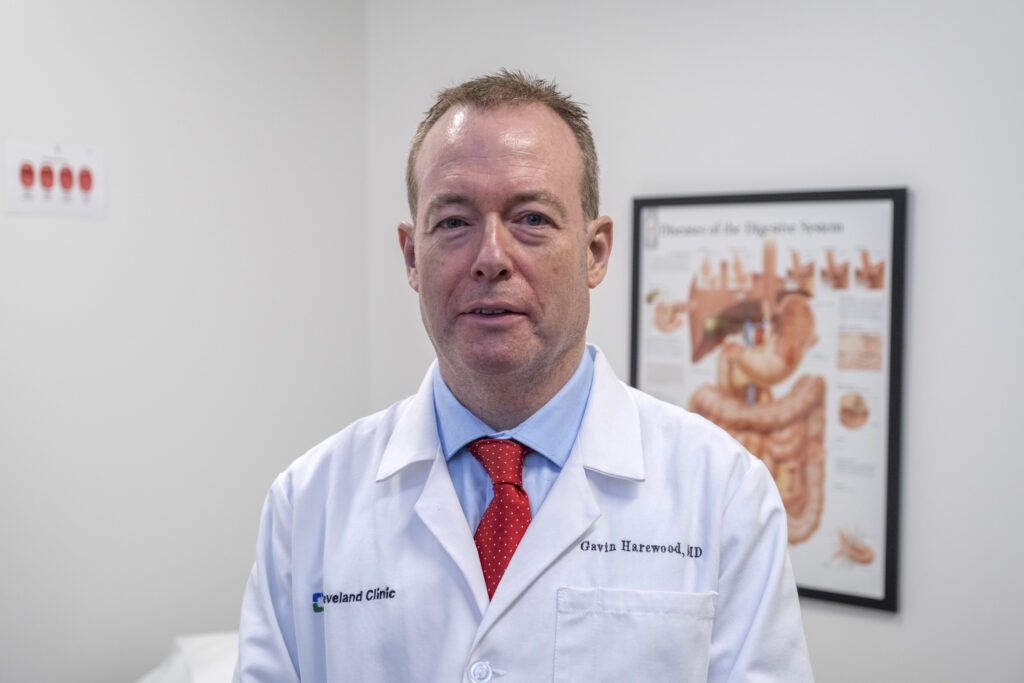Ahh … the pleasant month of March – known for balmy breezes, warmer temperatures and colorectal screenings. Excuse me? Yes, March is colorectal screening month and as unpleasant as it may sound, it is a lifesaving necessity.
The American Cancer Society estimates there will be about 106,590 new cases of colon cancer (54,210 in men and 52,380 in women) and about 46,220 new cases of rectal cancer (27,330 in men and 18,890 in women) in the U.S. this year.
While the rate of people being diagnosed with colon or rectal cancer each year has dropped by about 1 percent a year since the mid-1980s, the downward trend is mostly due to less cancer in older adults. In people younger than 55 years of age, rates have been increasing by 1 percent to 2 percent each year since the mid-1990s.
“The downward trend for older adults can be attributed to early screenings and intervention,” said Dr. Gavin Harewood, gastroenterologist at Cleveland Clinic Indian River Hospital. “The whole concept of screening for colon cancer came into vogue in the late 1990s thanks to a reporter named Katie Couric. Her husband passed away at a young age from colon cancer and she decided to boost the public awareness of the benefits of colonoscopy by having her procedure televised on morning TV. After the show, the number of people having colonoscopies increased by 20 percent. We call it the Katie Couric effect.
“Unfortunately, at the same time, there’s been an increase in colon cancer in people under the age of 55,” Dr. Harewood continued. “In the mid-1990s only about 11 percent of colon cancers were detected in younger people. By 2019 those numbers had increased to 20 percent, with one out of five colon cancers now detected in patients under the age of 55.
Because of these statistics, the American Cancer Society has lowered the start-up screening age from 50 to 45 and from age 40 if someone has a family history of colon cancer.”
Overall, the lifetime risk of developing colorectal cancer is about 1 in 23 for men and 1 in 25 for women. And while colorectal cancer is one of the most curable cancers, it remains the third leading cause of cancer-related deaths in men and the fourth leading cause in women.
The death rate from colorectal cancer has been dropping in older adults for decades thanks to early screening and detection of polyps that can be removed before they can develop into cancers.
“It circles back to the whole rationale for colonoscopy being the gold standard of care because we often find polyps which are precancerous growths on the lining of the colon,” Dr. Hare explained. “When we find them, we remove them and, in many cases, we’re preventing what could potentially grow into a cancer in the outcome.”
Multiple studies have shown that the removal of precancerous polyps during a colonoscopy can reduce the risk of developing colorectal cancer by as much as 90 percent.
The colonoscopy procedure is relatively simple. As people who have been through it know, it starts the evening beforehand with a strong laxative to clean out the colon. The following day, the procedure is done under general anesthesia in a hospital setting. The doctor inserts a thin lighted tube to check for polyps or cancer inside the rectum and the entire colon.
During the test, the doctor can find and remove any polyps detected and most cancers. After 20 to 40 minutes, the patient wakes up from a nice nap, gets the results and goes home the same day.
“If the colonoscopy is completely healthy the patient comes back in 10 years,” Dr. Harewood continued. “If we find one or two polyps, they come back in five years. If we find a large polyp measuring over one centimeter in size, or three or more polyps of any size, they come back in three years.”
At-home stool tests, like the popular Cologuard product, are done once a year. They are less invasive than the hospital procedure but also less conclusive. For this test you receive a test kit from your provider and at home you use a small stick or brush to obtain a small amount of stool. You return the test kit to the doctor or lab where it’s tested for the presence of blood.
“The stool test is not as good as colonoscopy but it’s better than nothing,” Dr. Hare said. The tests can detect microscopic amounts of blood in the stool and altered DNA that can be a sign of cancer in the colon.
“If someone has a stool test that’s positive, they still need to go ahead and have a colonoscopy. If the stool test is negative, they have peace of mind.”
In addition to helping with prevention, colorectal cancer screenings lead to improved survival rates among those diagnosed with the disease. If colorectal cancer is caught early before it spreads to other parts of the body, the five-year survival rate is approximately 90 percent. If the cancer has already spread by the time of diagnosis, the five-year survival rate drops to around 14 percent. That sharp contrast underscores the importance of regular screenings to ensure a better chance of survival.
From early detection to prevention and improved survival rates, screenings are a powerful tool and should be a priority for everyone – particularly those with a higher risk due to age and family history – according to medical professionals. You can talk to your healthcare provider about which screening is right for you.
Dr. Gavin Harewood received his medical degree and internship from the National University of Ireland College Faculty of Medicine. He completed his residency in Internal Medicine at Mater Misericordiae Hospital in Dublin, Ireland, and the Mayo Clinic in Rochester, Minn., and his fellowship in gastroenterology at the Mayo Clinic. His office is located in the Rosner Family Health and Wellness Center at Cleveland Clinic’s Indian River Hospital in Vero Beach: 772-299-3511.

